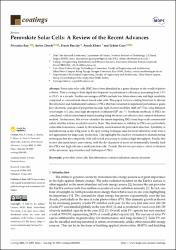Perovskite solar cells: A review of the recent advances
Künye
Roy, P., Ghosh, A., Barclay, F., Khare, A. & Cuce, E. (2022). Perovskite Solar Cells: A Review of the Recent Advances. Coatings, 12(8), 1089. https://doi.org/10.3390/coatings12081089Özet
Perovskite solar cells (PSC) have been identified as a game-changer in the world of photovoltaics. This is owing to their rapid development in performance efficiency, increasing from 3.5% to 25.8% in a decade. Further advantages of PSCs include low fabrication costs and high tunability compared to conventional silicon-based solar cells. This paper reviews existing literature to discuss the structural and fundamental features of PSCs that have resulted in significant performance gains. Key electronic and optical properties include high electron mobility (800 cm(2)/Vs), long diffusion wavelength (>1 mu m), and high absorption coefficient (10(5) cm(-1)). Synthesis methods of PSCs are considered, with solution-based manufacturing being the most cost-effective and common industrial method. Furthermore, this review identifies the issues impeding PSCs from large-scale commercialisation and the actions needed to resolve them. The main issue is stability as PSCs are particularly vulnerable to moisture, caused by the inherently weak bonds in the perovskite structure. Scalability of manufacturing is also a big issue as the spin-coating technique used for most laboratory-scale tests is not appropriate for large-scale production. This highlights the need for a transition to manufacturing techniques that are compatible with roll-to-roll processing to achieve high throughput. Finally, this review discusses future innovations, with the development of more environmentally friendly lead-free PSCs and high-efficiency multi-junction cells. Overall, this review provides a critical evaluation of the advances, opportunities and challenges of PSCs.


















